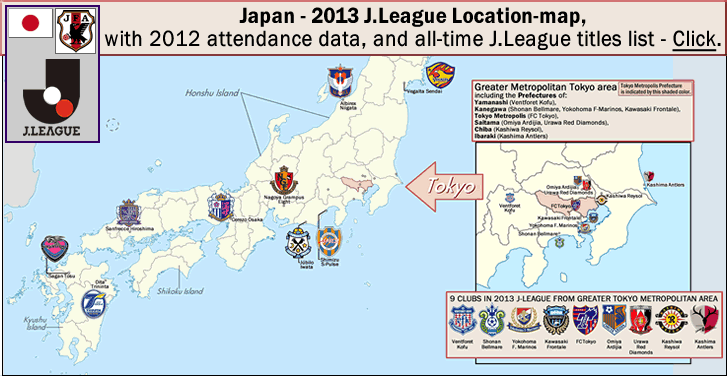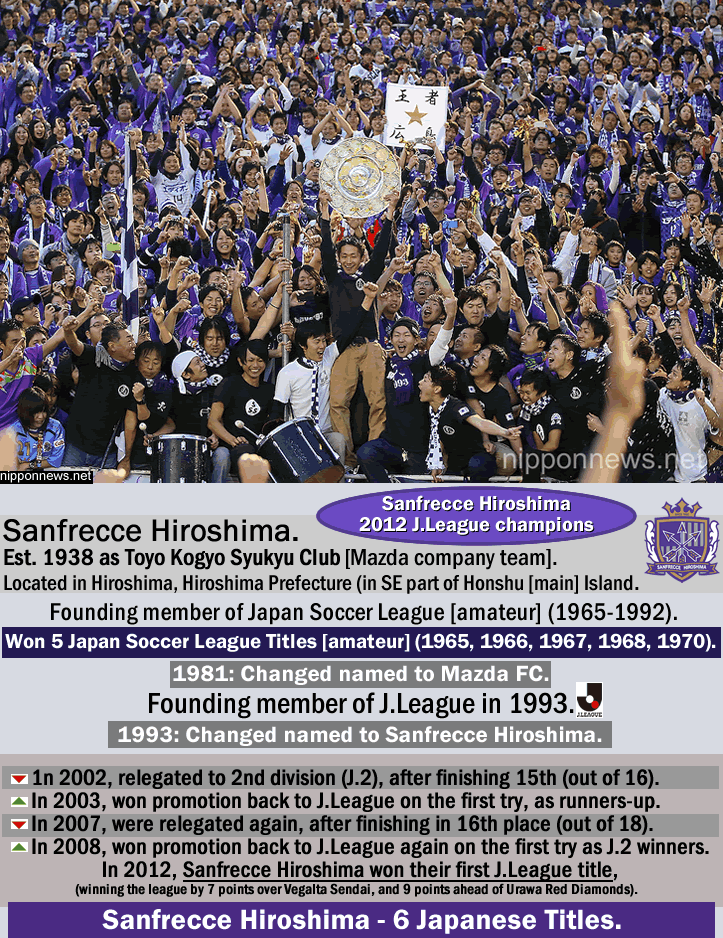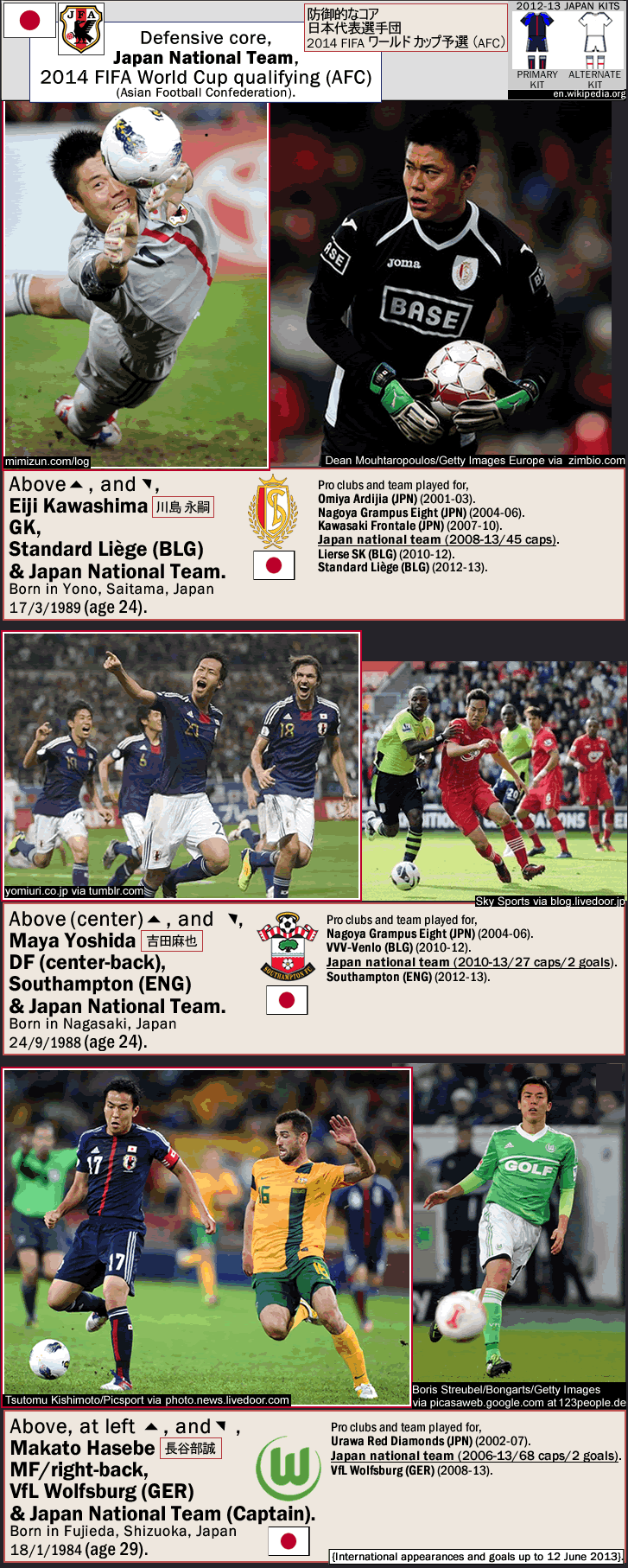
Japan: 2013 J-League location-map,with 2012 attendance data & J.League titles list
…
…
-
The J.League
J.1 (J. League Division 1) – fixtures, results, tables soccerway.com).
J.League official site – j-league.or.jp/eng.
‘2013 J. League Division 1‘ (en.wikipedia.org).
The J.League season runs from March to December. There are 18 teams in the league, making for a 34-game season. 3 clubs are relegated to J.2 each season and 3 clubs from J.2 are promoted to the first division at the end of each season. 2013 is the 18th season of the competition. Reigning champions are Sanfrecce Hiroshima, a venerable old club who finally won their first pro title in 2012. The most successful team is the Ibaraki prefecture-based Kashima Antlers, who have won 7 titles, last in 2009, and who are from the far eastern edge of Greater Metropolitan Tokyo, on the Pacific coast.
-
Elements of the map page (J.League 2013 location-map w/ 2012 attendance data & all-time J.League titles list [1993 to 2012])
At the far left is the 2013 J.League location-map, which includes 9 teams from the Greater Tokyo area. The 9 teams from the Greater Tokyo area (with home Prefactures listed) are shown in an inset map at the center of the map page.
At the upper-center of the map page is the all-time titles list for J.League (17 seasons/1993-2012). All-time Japanese title list (amateur and pro titles) can be seen at the following link – ‘List of Japanese football champions [amateur champions of Japan, 1965-1992/pro champions of Japan since 1993]‘ (en.wikipedia.org).
At the right-hand side of the map page is the 2012 attendance data for teams in the 2013 J.League, in chart form. 5 attendance data details are featured (going from left to right on the chart)…
-2011 average attendance;
-2012 average attendance;
-Percentage change from 2011 to 2012;
-Venue [stadium(s)] Capacity [Note: many J.League teams also play some home matches at a nearby larger municipal stadium - for teams that use 2 venues, both venue capacities are listed];
-Percent-Capacity or percent-capacities for 2012 home matches [Percent-Capacity equals Average attendance divided by Venue Capacity].
At the very bottom of the attendance data chart is the key for league movements, with:
-green arrow for promoted clubs (to J.1) for 2013 (Ventforet Kofu, Oita Trinita, and Shonan Bellmare);
-red arrow for relegated clubs (to J.2) for 2013 (Consadole Sapporo, Vissel Kobe, and Gamba Osaka);
-green asterisk for current J.1 teams which were promoted up 2 seasons ago (FC Tokyo and Sagan Tosu);
-red asterisk & green arrow for yo-yo clubs on the rebound back to J.1 for 2013 (Ventforet Kofu);
-green asterisk & red arrow for yo-yo clubs going back down to J.2 again for 2013 (Consadole Sapporo).
…
-
The history of the promotion/relegation format in Japanese association football
Japan Soccer League (1965-92) [amateur].
Prior to the J.League, there was the Japan Soccer League (JSL), established in 1965 as the second national sports league in Japan (following baseball, in 1936). The JSL was full of company teams, many of whom have morphed into J.League football clubs, such as Urawa Red Diamonds [formerly Mitsubishi Motors' company team], Kashiwa Reysol [formerly Hitachi electronics company team] and Sanfrecce Hiroshima [formerly Toyo Industries (Mazda) company team]. The JSL remained amateur for its entire 28-year existence (1965 to 1992).
Prior to the JSL, the major-league sports model in Japan was based exactly on the American franchise sports model – with no relegation or promotion, and with franchise shifts allowed, and with the periodic inception of new expansion franchises. Specifically, Nippon Professional Baseball (Japanese major league baseball), and their complete emulation of Major League Baseball (which has 29 American teams and 1 Canadian team, all of whom have affiliations with minor league teams which are in fixed leagues that do not have promotion/relegation… just like the 16 teams in Japan’s Nippon Professional Baseball).
But when it came to another sport (association football), with a decidedly different but very well-established and proven professional system, Japan sensibly ended up (twice) doing what around 98 percent of the rest of the world has ended up doing (the most prominent exceptions being Major League Soccer based in USA/Canada; and in the A-League based in Australia/New Zealand). Japan has followed the British association football promotion/relegation model, which has been in place in English football since the late Nineteenth century {since 1888-89, see this ‘Promotion and relegation‘ (en.wikipedia.org)}.
In 1972, the [amateur] Japan Soccer League instituted promotion/relegation. And that format remained for the final 21 seasons of the amateur top-flight set-up in Japan (from 1971 to 1992). At the same time (1972) a national second division of Japanese association football was instituted – the Japan Soccer League Second Division. Among the founding 10 teams, 5 later on made in into the J.League: Toyota Motors (inaugural champion/ present-day J.League team Nagoya Grampus Eight), Yomiuri FC (present-day J.2 team Tokyo Verdy), Fujitsu (present-day J.League team Kawasaki Frontale), Kyoto Shiko Club (present-day J.2 team Kyoto Sanga), and Kofu Club (present-day j.League team Ventforet Kofu).
J.League, the first pro league of association football in Japan. Establishd 1993.
The J.League was established in 1993, as the first nation-wide professional league for association football in Japan. The people running the J.League in its early days (circa 1992 to ’97) tried to make it a closed shop (with no relegation, and with expansion clubs coming up only sporadically as de-facto promoted clubs [via the now-defunt Japan Football League (1992–98)]. But there was no corresponding relegation, so mediocre-to-outright-poor-teams were safe, and complacency set in.
By the mid-1990s, after the initial excitement about the new pro league faded, attendances eventually ended up plummeting – a 44% decline, from 17,975 per game in the first J.League season in 1993, to only 10,130 per game four years later in 1997. So the folks who ran the league then saw the light, and they instituted promotion/relegation. In 1999, the first professional Japanese second division was established – J.League Division 2 (aka J.2). Just prior to that, a promotion/relegation system was instituted, and some of the 1998 J.League teams ended up being relegated into the newly-formed pro Japanese second division in 1999.
Japan’s professional association football league format has included promotion/relegation for over 15 years now. (1998 season to 2013). Attendance was up 11.1% last season (2012), at an average of 17,565 per game {see this, ‘J.League 2012 – Attendance -’ (worldfootball.net)}. 4 football clubs in Japan averaged over 20,000 per game in 2012: Urawa Red Diamonds (of the northern suburbs of Greater Tokyo in Saitama prefecture), Albirex Niigata (from the west coast/Sea of Japan city of Niigata), the recently-promoted club FC Tokyo (of Tokyo Metropolis prefecture), and Yokohoma F. Marinos (of Yokohoma/Greater Tokyo).
In the 15 seasons since promotion/relegation has been established in Japanese pro football, exactly zero Japanese football clubs who have suffered relegation have gone out of business. That is 34 relegations, with 20 different clubs having been relegated from the Japanese first division since 1998 {see this, ‘J.League Division 1/Relegation history‘ (en.wikipedia.org)}. As a matter of fact, the reigning champions of Japan, the first-time J.League winners Sanfrecce Hiroshima (from the western region of the main island of Honshu), were recently relegated – in 2007. Sanfrecce Hiroshima then were promoted back to the top flight the following season. Then Sanfrecce Hiroshima won the J.League title 6 years after being relegated.
For 3 straight seasons, now, a club that had never won the J.League title has been champion. For 2 straight seasons, now, a club that had recently been relegated has been champion. And one of those clubs was not a founding member of J.League. 2010 J.League winners were the central Japan-based Nagoya Grampus Eight [Arsene Wenger's old club]. 2011 winners were the Chiba/east-side-of-Greater-Tokyo-based club Kashiwa Reysol. [Kashiwa Reysol are from Kashiwa, Chiba prefecture, around 33 km. or 20 miles east of central Tokyo, in the same prefecture as the NPB ball club the Chiba Lotte Marines.]
Kashiwa Reysol, established in 1940 as Hitachi, Ltd. Soccer Club in Kodaira, Tokyo, were a successful club throughout the amateur era but ended up waiting a bit longer than many other Japanese footballl clubs to turn pro (circa the early 1990s), and were thus left out of the initial line-up of clubs that made up the inaugural season of J.League in 1993. So they had to play their way into the league, which they first did in 1994, back when the J.League was expanding, but had not yet arrived at the decision to become a 2-tier pro set-up with promotion/relegation.
Kashiwa Reysol has also recently suffered the set-back of being relegated – twice – in 2005, then again in 2009. Kashiwa Reysol then became the first Japanese team to ever win back-to-back titles in J.2 (in 2010) then in J.League (in 2011, winning the crown by 1 point over reigning champions Nagoya Garampus Eight, and 2 points ahead of Gamba Osaka).
So in 2011, Kashiwa Reysol became the first team to earn promotion from J.2 to J.1, and then win the J.League title in the following season – joining that unique group of clubs which have won the national title the season after getting promoted to the first division (clubs such as Ipswich Town in 1962, Nottingham Forest in 1978, and FC Kaiserslautern in 1998). Granted, with the current state of finances of top flight football in England and Germany (and elsewhere), it is unlikely (without a wage cap) that we will see another incidence of a just-promoted club winning the title the following year in the Premier League, or in the Bundesliga. But, nevertheless, the possibility is still there. And regardless, the format of promotion/relegation is constantly injecting new life into the top flight – witness the captivating rise and success of Swansea City. You will never see a story like Swansea City occur in Major League Soccer, because there is no way on Earth that MLS would grant a franchise to a city as small as Swansea (which has a population of only 239,000 {2011 figure}). Major League Soccer is a league that refuses to implement a promotion/relegation system, because they are afraid that their franchises couldn’t survive a year in a theoretical second division. So all the fans of association football that are from mid-sized American cities know they will never have the chance to see their hometown soccer team ever make it to the top flight, unlike in England, and in France, and in Germany, and in Spain, and in Italy, and in Mexico, and in Brazil, and in Argentina, and in Japan. Because MLS is full of soccer franchises, instead of football clubs.
Japan’s J.League proves that a nation that once used only the franchise model for a national sports league can successfully implement the promotion/relegation model. And create more fan excitement, and increase attendance.
Here is an excerpt from this article from footiebusiness.com, from Nov. 20, 2012, by Ben Berger, ‘What American Soccer Can Learn from Japan‘, …{excerpt}…’ the J. League decided to create a lower “J2” league in 1999 to go along with the top league, now called “J1”. With this, they also instituted promotion and relegation. One result? Better marketing opportunities for the sport, with fans’ passion being upped a notch, and relegation battles being contested and publicized as much as championships. Take the example of Kashiwa Reysol…which was relegated from J1 in the 2009 season yet was promoted back the next year. Incredibly, Kashiwa won the J1 championship in 2011. That’s what dreams are made of – the key reason people follow sports. Nothing like it exists in North American sport.’ …{end of excerpt’}.
2011 J.League champions – Kashiwa Reysol.

Photo and Image credits above -
Screenshot of a youtube.com video uploaded by jleague, ‘Kashiwa Reysol Vs Vegalta Sendai: J- League 2012 (Round 6)‘.
Kashiwa Reysol averaged a modest 13,768 last season, but boasted the second-best percent-capacity rate in J.League in 2012, at 77%-capacity at their smart and compact and running-track-free/4-separate-stands/15,900-capacity Hitachi Kashiwa Soccer Stadium. That percent-capacity figure was second only to north-Honshu Island-based Vegalta Sendai at 84 %-capacity in 2012 {see attendance chart on map above for full figures, which I got here (int.soccerway.com/japan}.
…
In 2012, Sanfrecce Hiroshima, a club that has been relegated twice in the last 11 seasons (in 2002 and in 2007), won the J.League title. That the last two teams to win the title in Japan had both been recently been relegated shows the beauty of promotion and relegation. And in the 15 years since J.League adopted the promotion/relegation model, attendance has rebounded dramatically, rising over 7,000 per game, from that aforementioned low of 10,130 per game in 1997, to the 17,565 per game the J.League drew last year.
2012 J.League champions – Sanfrecce Hiroshima. Sanfrecce Hiroshima averaged 6th-best in J.League in 2012, at 17,720 per game (up 34.2% from 2011).

Photo and Image credits above -
nipponnews.net/en/sports/hiroshima-sanfrecce-crowned-j-league-2012-champions
{Note: for some attendance data above, see this Japanese football site goal2002.com.
…
-
Japan national football team: 2014 FIFA World Cup qualifying (Asian Football Confederation) – coach & top players in the current roster
Japan are the first team to qualify for the 2014 FIFA World Cup in Brazil.
Japan has now qualified for 5 consecutive FIFA World Cups.
From Guardian.co.uk/football, from 4 June 2013, ‘Australia concede late equaliser to Japan in World Cup qualifier
• Japan 1-1 Australia
• Samurai Blue qualify for the World Cup‘ (guardian.co.uk).

Photo and Image credits above -
‘Japan national football team‘ (en.wikipedia.org).
Yoshida at japantimes.co.jp.
…
-
Below – Top scoring threats on the Japan National Football team,
Shinji Kagawa (MF), Keisuke Honda (FW), Shinji Okazaki (FW) -

Photo and Image credits above -
‘Japan national football team‘ (en.wikipedia.org).
Koji Sasahara/AFP at foxsports.com.au/talents-like-shinji-kagawa-lead-regeneration-of-japanese-football-as-australia-struggle-to-meet-demands.
Shaun Botterill/Getty Images Europe via zimbio.com.
AP via japantimes.co.jp.
Unattributed at talksport.co.uk.
vfb.de.
shikoku-np.co.jp/sports/soccer.
…
-
Below – defensive core of the Japan National Football team, FIFA 2014 World Cup qualifying (Asian Football Confederation)…
Eiji Kawashima (GK), Maya Yoshida (DF), Makoto Hasebe (MF & captain) -

Photo and Image credits above -
‘Japan national football team‘ (en.wikipedia.org).
mimizun.com/log.
Dean Mouhtaropoulos/Getty Images Europe via zimbio.com.
Sky Sports via blog.livedoor.jp
yomiuri.co.jp via tumblr.com/tagged/maya yoshida.
Tsutomu Kishimoto/Picsport at photo.news.livedoor.com.
Boris Streubel/Bongarts/Getty Images) via Picasaweb at 123people.de/s/makoto+hasebe.
…
___
Thanks to Maximilian Dörrbecker at de.wikipedia.org for the blank map of Japan, http://en.wikipedia.org/wiki/File:Japan_location_map_with_side_map_of_the_Ryukyu_Islands.svg.
Thanks to worldfootball.net for J.League attendances, http://www.worldfootball.net/zuschauer/jpn-j-league-2012/1/.
Thanks to Goal2002.com for J.league Divisions 1 and 2 attendance data, http://www.goal2002.com/2012/tables.html ; 2011 j.League attendance data, http://www.goal2002.com/2011/tables.html.
Thanks to soccerway.com for J.League stadium capacities and percent-capacities, http://int.soccerway.com/national/japan/j1-league/2012/regular-season/r17068/.
Thanks to this section at the official J.League site, for stadia info, http://www.j-league.or.jp/stadium/ [J.League stadium guide].
